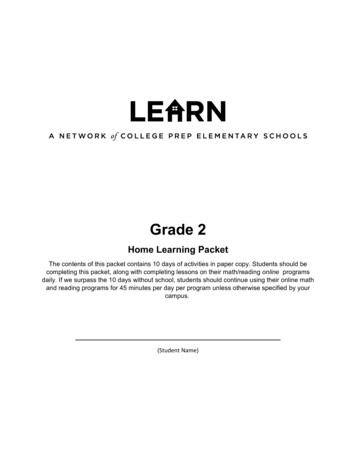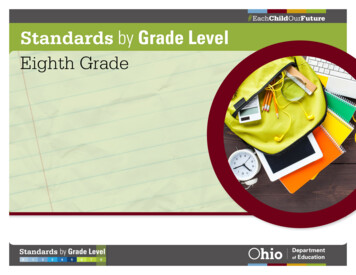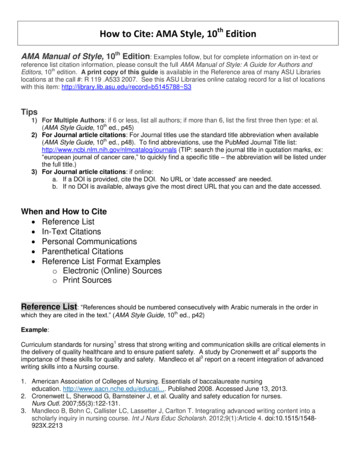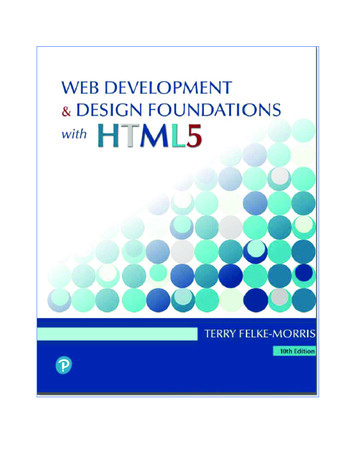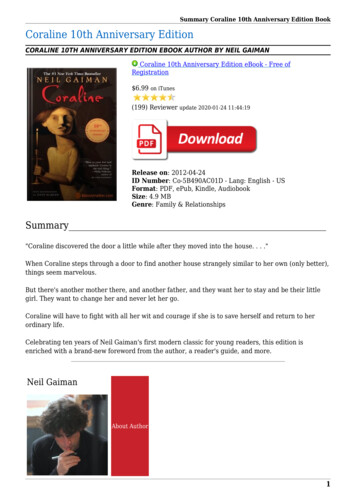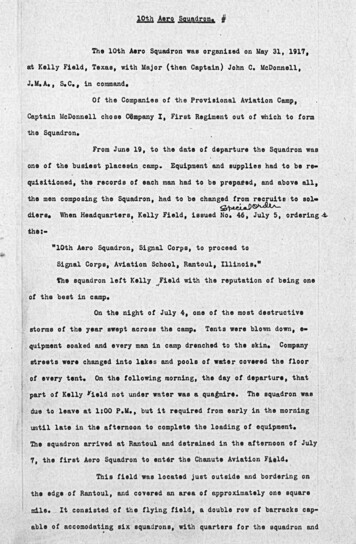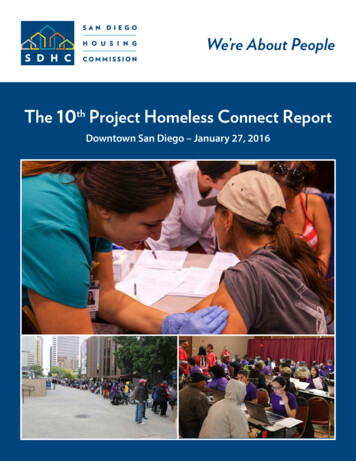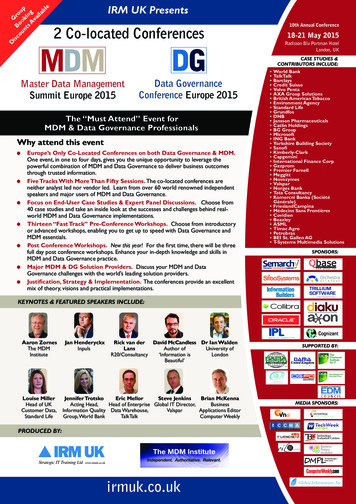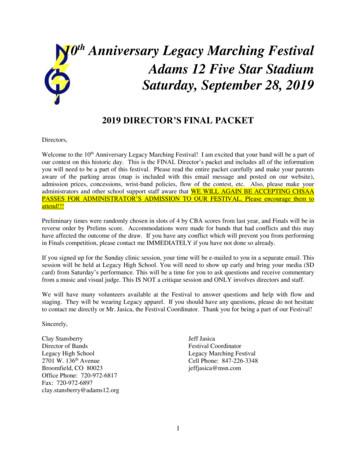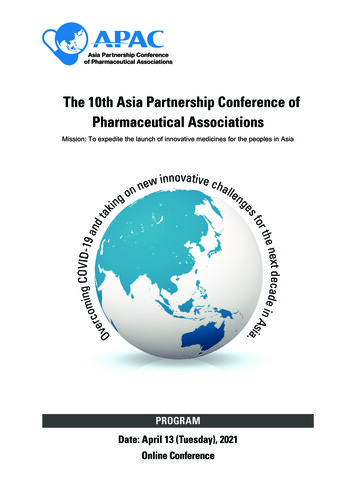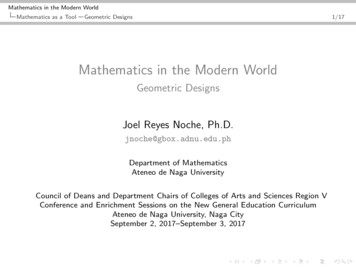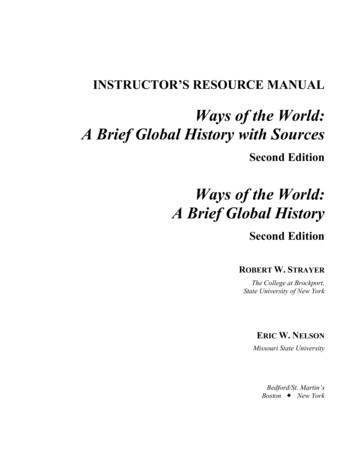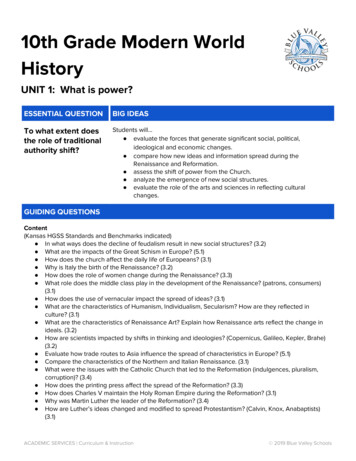
Transcription
10th Grade Modern WorldHistoryUNIT 1: What is power?ESSENTIAL QUESTIONBIG IDEASTo what extent doesthe role of traditionalauthority shift?Students will. evaluate the forces that generate significant social, political,ideological and economic changes. compare how new ideas and information spread during theRenaissance and Reformation. assess the shift of power from the Church. analyze the emergence of new social structures. evaluate the role of the arts and sciences in reflecting culturalchanges.GUIDING QUESTIONSContent(Kansas HGSS Standards and Benchmarks indicated) In what ways does the decline of feudalism result in new social structures? (3.2) What are the impacts of the Great Schism in Europe? (5.1) How does the church affect the daily life of Europeans? (3.1) Why is Italy the birth of the Renaissance? (3.2) How does the role of women change during the Renaissance? (3.3) What role does the middle class play in the development of the Renaissance? (patrons, consumers)(3.1) How does the use of vernacular impact the spread of ideas? (3.1) What are the characteristics of Humanism, Individualism, Secularism? How are they reflected inculture? (3.1) What are the characteristics of Renaissance Art? Explain how Renaissance arts reflect the change inideals. (3.2) How are scientists impacted by shifts in thinking and ideologies? (Copernicus, Galileo, Kepler, Brahe)(3.2) Evaluate how trade routes to Asia influence the spread of characteristics in Europe? (5.1) Compare the characteristics of the Northern and Italian Renaissance. (3.1) What were the issues with the Catholic Church that led to the Reformation (indulgences, pluralism,corruption)? (3.4) How does the printing press affect the spread of the Reformation? (3.3) How does Charles V maintain the Holy Roman Empire during the Reformation? (3.1) Why was Martin Luther the leader of the Reformation? (3.4) How are Luther’s ideas changed and modified to spread Protestantism? (Calvin, Knox, Anabaptists)(3.1)ACADEMIC SERVICES Curriculum & Instruction 2019 Blue Valley Schools
Analyze the impact of the Act of Supremacy on the shift of power from the Church to monarchs. (3.3)What did the Catholic church do to maintain their power? (Catholic Reformation) (3.1)Process(NCSS C3 Framework Standards indicated) How do I explain how a question reflects an enduring issue in the field? (D1.1.9-12) How do I determine the kinds of sources that will be helpful in answering compelling and supportingquestions, taking into consideration multiple points of view represented in the sources, the types ofsources available, and the potential uses of sources? (D1.5.9-12) How do I critique relationships among governments, civil societies, and economic markets?(D2.Civ.6.9-12) How do I use maps, satellite images, photographs, and other representations to explain relationshipsbetween the locations of places and regions and their political, cultural, and economic dynamics?(D2.Geo.2.9-12) How do I analyze how incentives influence choices that may result in policies with a range of costs andbenefits for different groups? (D2.Eco.2.9-12) How do I analyze multiple and complex causes and effects of events in the past? (D2.His.14.9-12) How do I evaluate how political and economic decisions throughout time have influenced cultural andenvironmental characteristics of various places and regions? (D2.Geo.5.9-12) How do I gather relevant information from multiple sources representing a wide range of views whileusing origin, authority, structure, context, and corroborative value of the sources to guide theselection? (D3.1.9-12) How do I evaluate the credibility of a source by examining how experts value the source? (D3.2.9-12) How do I construct explanations using sound reasoning, correct sequence (linear or non-linear),examples and details with significant and pertinent information and data, while acknowledging thestrengths and weaknesses of the explanation given its purpose? (e.g., cause and effect, chronological,procedural, technical). (D4.2.9-12)Reflective What are the impacts of the shift from a religious to a more secular society? How do the results of the Reformation expand opportunities for women? What is the significance of the growth of the middle class? How are the ideals of a society reflected in the arts they create?FOCUS STANDARDSKansas History, Government, and Social Studies Standards The student will recognize and evaluate how societies are shaped by the identities, beliefs,and practices of individuals and groups. (3.1) The student will analyze context and draw conclusions about how societies are shaped by theidentities, beliefs, and practices of individuals and groups. (3.2) The student will investigate and connect how societies are shaped by the identities, beliefs,and practices of individuals and groups with contemporary issues. (3.3) The student will use their understanding of how societies are shaped by the identities, beliefs,and practices of individuals and groups to make a claim or advance a theory using evidenceand argument. (3.4) The student will recognize and evaluate dynamic relationships that impact lives in communities,states, and nations. (5.1) The student will use their understanding of dynamic relationships to make a claim or advance a thesisusing evidence and argument. (5.4)ACADEMIC SERVICES Curriculum & Instruction 2019 Blue Valley Schools
10th Grade Modern WorldHistoryUNIT 2: What else is out there?ESSENTIAL QUESTIONBIG IDEASHow do globalinteractions shape theworld?Students will. evaluate how the ideas of the Renaissance lead to the period ofexploration. critique the motives that led to exploration of the world. examine the means that led to exploration of the world. compare the different responses to European exploration onindigenous populations. examine the process of colonization. compare why some nations chose to expand while others do not. analyze the impacts of the spread of ideas between groups.GUIDING QUESTIONSContent(Kansas HGSS Standards and Benchmarks indicated) How did the Renaissance lead to the Age of Exploration? (3.3) What/How Renaissance ideas lead to the start of the Age of Exploration? (Humanism,individualism, secularism) (2.1) How did the exchange of new ideas lead to the exploration? (3.2) What inspires monarchs to expand their nations? (2.1) What are the means that allow exploration during this time period? (new technology - Caravel, sextant,financial support, and state supported--include ‘new science’) (2.1) How did the expansion and cultural difference of the Muslim empires drive Europeans to explore? (3.4) What motives led people to explore new areas of the World? (3.1) Why did Europeans choose to explore? (God, Gold, and Glory) (2.4) Why did China (Zheng He) choose to explore? (2.4) What was the response of the Aztecs to the arrival of the Spanish? (3.1) What is the response of the Incas to the arrival of the Spanish? (3.1) What is the response of the African Empires to European exploration? (Ghana and Songhai empires).(3.1) How does the Triangular Trade routes impact African societies? (2.1) How are the Triangular Trade routes an economic driver in the Atlantic? (2.1) What is the experience of enslaved peoples of Africa on route and in the colonies? (3.1) What are the impacts of these new global connections? (3.3)ACADEMIC SERVICES Curriculum & Instruction 2019 Blue Valley Schools
Impact of the Colombian Exchange? (3.3)What cultural blending takes place because of these new connections? (Safavid Empire,Ottoman Empire, Spanish Empire, Mughal Empire) (3.3)How does the process of colonization drive the economic competition that will dominate the globaleconomy? (mercantilism, manufacturing, imperialism) (2.1)Why did China and Japan choose isolation as their foreign policy in the 1600s? (closed door policy,Closed country Edict) (3.4) Process(NCSS C3 Framework Standards indicated) How do I determine the kinds of sources that will be helpful in answering compelling and supportingquestions, taking into consideration multiple points of view represented in the sources, the types ofsources available, and the potential uses of the sources? (D1.5.9-12). How do I evaluate how historical events and developments were shaped by unique circumstances oftime and place as well as broader historical contexts? (D2.His.1.9-12) How do I analyze multiple and complex causes and effects of events in the past? (D2.His.14.9-12) How do I critique relationships among governments, civil societies, and economic markets?(D2.Civ.6.9-12) How do I analyze the reciprocal nature of how historical events and the spatial diffusion of ideas,technologies, and cultural practices have influenced migration patterns and the distribution of humanpopulation? (D2.Geo.7.9-12) How do I describe the consequences of competition in specific markets? (D2.Eco.5.9-12) How do I construct explanations using sound reasoning, correct sequence (linear or non-linear),examples and details with significant and pertinent information and data, while acknowledging thestrengths and weaknesses of the explanation given its purpose? (e.g., cause and effect, chronological,procedural, technical) (D4.2.9-12)Reflective How do we see the interactions of Europe and America impact us today? How does discovery lead to innovation? What role does geography play in modern foreign policy? How does the demand for resources shape conflict? What are the current resources that societies arecompeting for? What new technologies connect global citizens today? Is conquest justifiable?FOCUS STANDARDSKansas History, Government, and Social Studies Standards The student will recognize and evaluate the rights and responsibilities of people living in societies.(2.1) The student will use their understanding of rights and responsibilities to make a claim or advance athesis using evidence and argument. (2.4) The student will recognize and evaluate how societies are shaped by the identities, beliefs,and practices of individuals and groups. (3.1) The student will analyze context and draw conclusions about how societies are shaped by theidentities, beliefs, and practices of individuals and groups. (3.2) The student will investigate and connect how societies are shaped by the identities, beliefs,ACADEMIC SERVICES Curriculum & Instruction 2019 Blue Valley Schools
and practices of individuals and groups with contemporary issues. (3.3)The student will use their understanding of how societies are shaped by the identities, beliefs,and practices of individuals and groups to make a claim or advance a theory using evidenceand argument. (3.4)10th Grade Modern WorldHistoryUNIT 3: Who governs whom?ESSENTIAL QUESTIONBIG IDEASWhat impact doesauthority have on itspeople?Students will. analyze the factors that contribute to the rise of Absolute ideologies. critique the success and failures of Absolutism in various countries. compare Absolutism and Constitutionalism. examine the rights and responsibilities of both leaders and citizens. evaluate the role of the arts and sciences in reflecting culturalchanges. analyze how the Enlightenment challenged existing religious, social,political, and economic ideas .GUIDING QUESTIONSContent(Kansas HGSS Standards and Benchmarks indicated) How did the decline of the Catholic Church lead to the rise of Absolutism? (2.2) What are the characteristics of Absolutism? (Divine Right, Expansion policies, high taxes, reducingpower of nobility) (2.2) What makes Louis XIV the best example of Absolutism? (3.2) How do other monarchs compare to Louis XIV’s example of Absolutism? (Peter the Great, Suleimanthe Magnificent, Emperor Qianlong of China, Tokugawa Ieyasu, Catherine the Great, Joseph II, MariaTheresa) (3.2) How do Absolute monarchs use their power to control changes in the sciences and arts? (FrenchAcademy of Sciences by Louis XIV, Baroque art) (2.2) How does the Thirty Years War signify a shift in motives for conflict? (3.2) What caused England to reject an absolute monarch? (English Civil War, Constitutionalism) (3.2) What are the characteristics of Constitutionalism? (2.2) Compare the role secularism has in the shift of political motives for authority figures? (3.2) How did social and political changes help foster innovation in the sciences? (Newton, Bacon,Descartes, scientific instruments) (2.4) How do new scientific processes and ideas impact the Enlightenment? (2.4)ACADEMIC SERVICES Curriculum & Instruction 2019 Blue Valley Schools
What new ideas of the Enlightenment lead to social change? (Voltaire, Wollstonecraft, Astell) (3.2)How do the new ideas of the Enlightenment impact how governments work? (Locke, Hobbes,Montesquieu, Rousseau, Voltaire, Beccaria) (2.3)How did the new ideas of the Enlightenment challenge existing religious ideas? (Voltaire) (3.2)What new ideas of the Enlightenment result in economic changes? (Adam Smith) (3.2)How were social and political changes reflected in the visual arts, music, and architecture? (Baroque,Rococo and Neoclassical) (2.2)Process(NCSS C3 Framework Standards indicated) How do I explain how a question reflects an enduring issue in the field? (D1.1.9-12) How do I analyze change and continuity in historical eras? (D2.His.2.9-12) How do I analyze multiple and complex causes and effects of events in the past? (D2.His.14.9-12) How do I critique relationships among governments, civil societies, and economic markets?(D2.Civ.6.9-12) How do I apply civic virtues and democrats principles when working with others? (D2.Civ.7.9-12) How do I evaluate the credibility of a source by examining how experts value the source?(D3.2.9-12) How do I construct explanations using sound reasoning, correct sequence (linear or nonlinear),examples, and details with significant and pertinent information and data, while acknowledging thestrengths and weaknesses of the explanation given its purpose (e.g., cause and effect, chronological,procedural, technical). (D4.2.9-12)Reflective Where do you see the Enlightenment ideologies in governments today? How are the scientific discoveries of this time period still utilized in modern science? What are your roles and responsibilities as a citizen?FOCUS STANDARDSKansas History, Government, and Social Studies Standards The student will analyze the context and draw conclusions about rights and responsibilities. (2.2) The student will investigate and connect the rights and responsibilities of individuals withcontemporary issues. (2.3) The student will use their understanding of rights and responsibilities to make a claim or advance athesis using evidence and argument. (2.4) The student will analyze context and draw conclusions how societies are shaped by identities, beliefsand practices of individuals and groups with contemporary. (3.2)ACADEMIC SERVICES Curriculum & Instruction 2019 Blue Valley Schools
10th Grade Modern WorldHistoryUNIT 4: Who governs whom?ESSENTIAL QUESTIONBIG IDEASHow do people forcechange?Students will. examine enlightened ideologies in the American and FrenchRevolution. compare the causes of different revolutions around the world. analyze the efficacy of the Revolutions in achieving greater popularsovereignty and civil liberties. assess the role nationalism plays in political revolutions.GUIDING QUESTIONSContent(Kansas HGSS Standards and Benchmarks indicated) What Enlightenment ideas are reflected in the founding documents of the United States? (1.4) What causes led to the American Revolution? (economic, nationalistic) (1.2) What social, economic and political inequalities led to the outbreak of the French Revolution? (EstatesSystem, debt, ineptness of Louis XVI) (1.2) How does propaganda steer public opinion in turbulent times? (1.2) What Enlightenment ideas are reflected in the guiding documents for the French Revolution?(Declaration of the Rights of Man, Declaration of the Rights of Women) (4.2) What role did women play in the French Revolution? (1.2) How does the French Revolution deviate from the pattern of revolution in other countries? (Phases ofthe French Rev, outcome resulting in Napoleon) (4.4) How did Napoleon blend together ideas of absolutism and the enlightenment to be a successfulemperor? (Napoleonic Code, Napoleonic wars, views on women, social changes) (1.2) How does Napoleon’s take over of Europe result in new political ideologies? (conservatism andliberalism) (1.4) What are the characteristics of 19th century conservatism? (1.2) What are the characteristics of 19th century liberalism? (1.2) How does the Congress of Vienna and the Concert of Europe exemplify the characteristics of19th century conservatism? (1.2) How were the motives of the Haitin Revolution different from the other revolutions of the time? (1.2) What were the motives of the Latin American Revolutions? (Mexico, Brazil, Bolivar’s rev - Venezuela,Colombia, Ecuador) (1.2) What are the characteristics of Nationalism? (1.2)ACADEMIC SERVICES Curriculum & Instruction 2019 Blue Valley Schools
How were the Italian and German unification a result of the rise of nationalism? (4.2)Process(NCSS C3 Framework Standards indicated) How do I explain points of agreement and disagreement experts have about interpretations andapplications of disciplinary concepts and ideas associated with a compelling question? (D1.2.9-12) How do I analyze change and continuity in historical eras? (D2.His.2.9-12) How do I analyze complex and interacting factors that influenced the perspectives of people duringdifferent historical eras? (D2.His.4.9-12) How do I distinguish between long-term causes and triggering events in developing a historicalargument? (D2.His.15.9-12) How do I evaluate social and political systems in different contexts, times, and places, that promotecivic virtues and enact democratic principles? (D2.Civ.8.9-12) How do I analyze how people use and challenge local, state, national, and international laws toaddress a variety of public issues? (D2.Civ.12.9-12) How do I generate possible explanations for a government role in markets when market inefficienciesexist? (D2. Eco.6.9-12.) How do I construct arguments using precise and knowledgeable claims, with evidence from multiplesources, while acknowledging counterclaims and evidentiary weaknesses? (D4.1.9-12) How do I use disciplinary and interdisciplinary lenses to understand the characteristics and causes oflocal, regional, and global problems; instances of such problems in multiple contexts; and challengesand opportunities faced by those trying to address these problems over time and place? (D4.6.9-12)Reflective How can citizens change the way in which they are governed? How does the media affect public opinion today? What does 21st century conservatism and liberalism look like? What does nationalism look like today? What impact would nationalism have today in our globalized economy? What would a modern revolution look like?FOCUS STANDARDSKansas History, Government, and Social Studies Standards The student will analyze the context and draw conclusions about choices and consequences. (1.2) The student will use his/her understanding of choices and consequences to make a claim or advancea thesis using evidence and argument. (1.4) The student will analyze the context and draw conclusions about continuity and change. (4.2) The student will use their understanding of continuity and change to make a claim or advance a thesisusing evidence and argument. (4.4)ACADEMIC SERVICES Curriculum & Instruction 2019 Blue Valley Schools
10th Grade Modern WorldHistoryUNIT 5: It’s a Small WorldESSENTIAL QUESTIONBIG IDEASWhat drives theglobal economy?Students will. evaluate the impact of the Agricultural Revolution on the IndustrialRevolution. evaluate the impacts of the Industrial Revolution. analyze the forces that drive Imperialism. compare the reactions to European Imperialism. analyze the different forms of Imperialism.GUIDING QUESTIONSContent(Kansas HGSS Standards and Benchmarks indicated) How does the agricultural revolution lead to the Industrial Revolution? (5.2) Why does the Industrial Revolution begin in England? (2.2) What technologies make industrialization possible? (2.1) Compare the cottage industries and factory systems? (5.3) What problems are caused by industrialization? (Child labor, wage gap, pollution) (5.3) How do these issues lead to new socio political ideologies? (socialism and communism) (5.2) What is some of the backlash to industrialization? (2.2) How does the Industrial Revolution shape economic ideologies in the 19th and 20th Centuries? (5.4) What are the geographic changes caused by the Industrial Revolution? (Population increase,urbanization) (5.1) Why does industrialization lead to imperialism? (5.4) How do Europeans justify Imperialism? (White man’s burden) (2.4) What are the different forms of Imperialism used in the 19th Century? (Indirect, direct, sphere ofinfluence) (2.2) How does the Berlin Conference fast track Imperialism? (5.3) How do some countries avoid imperialism while others are imperialized? (Japan and Ethiopia) (2.2) What are the consequences for countries that are slower to industrialize? (China, Boer Republic) (2.4)Process(NCSS C3 Framework Standards indicated) How do I determine the kinds of sources that will be helpful in answering compelling and supportingquestions, taking into consideration multiple points of view represented in the sources, the types ofsources available, and the potential uses of sources? (D1.5.9-12) How do I analyze change and continuity in historical eras? (D2.His.2.9-12) How do I analyze how historical contexts shaped and continue to shape people’s perspectives?(D2.His.5.9-12) How do I analyze multiple and complex causes and effects of events in the past? (D2.His.14.9-12)ACADEMIC SERVICES Curriculum & Instruction 2019 Blue Valley Schools
How do I analyze how incentives influence choices that may result in policies with a range of costs andbenefits for different groups? (D2.Eco.1.9-12)How do I analyze the ways in which incentives influence what is produced and distributed in a marketsystem? (D2.Eco.3.9-12)How do I describe the consequences of competition in specific markets? (D2.Eco.5.9-12)How do I explain why advancements in technology and investments in capital goods and humancapital increase economic growth and standards of living? (D2.Eco.13.9-12)How do I evaluate how political and economic decisions throughout time have influenced cultural andenvironmental characteristics of various places and regions? (D2.Geo.5.9-12)How do I evaluate how economic globalization and the expanding use of scarce resources contributeto conflict and cooperation within and among countries? (D2.Geo.11.9-12)How do I gather relevant information from multiple sources representing a wide range of views whileusing the origin, authority, structure, context, and corroborative value of the sources to guide theselection? (D3.1.9-12)How do I construct arguments using precise and knowledgeable claims, with evidence from multiplesources, while acknowledging counterclaims and evidentiary weaknesses? (D4.1.9-12)Reflective Who should an economy serve most? What have we learned from the industrial revolution? Have we corrected or fixed them? What are the effects of imperialism on the world today? Compare the progress made by the industrial revolution and the technology revolution of the 1980sand 1990s. What are the residual impacts of the Conference of Berlin on Africa today? What are the different types of imperialism today?FOCUS STANDARDSKansas History, Government, and Social Studies Standards The student will recognize and evaluate the rights and responsibilities of people living in societies. (2.1) The student will analyze the context and draw conclusions about rights and responsibilities. (2.2) The student will use their understanding of rights and responsibilities to make a claim or advance athesis using evidence and argument. (2.4) The student will analyze the context and draw conclusions about dynamic relationships. (5.2) The student will investigate and connect dynamic relationships to contemporary issues. (5.3) The student will use their understanding of dynamic relationships to make a claim or advance a thesisusing evidence and argument. (5.4)ACADEMIC SERVICES Curriculum & Instruction 2019 Blue Valley Schools
10th Grade Modern WorldHistoryUNIT 6: Extreme ReactionsESSENTIAL QUESTIONBIG IDEASWhat causes extremereactions in society?Students will. differentiate between extreme ideologies. examine the causes that led to the first World War. compare the impacts of WWI on the winners and losers. assess how warfare has changed. critique the impacts of the Treaty of Versailles and how it failed.GUIDING QUESTIONSContent(Kansas HGSS Standards and Benchmarks indicated) What are the MAIN causes of World War I? (5.1) What makes WWI the first total and industrialized war? (3.4) New inventions - planes, tanks, chemical warfare, mechanized warfare Impact on civilians (homefront and along the battle lines) How did the role of women change from the start of the war moving into the 20th century?(Work-force, suffrage, Russian combat troop) (3.3) How did suffragettes such as Emeline Pankhurst impact the suffrage movement? (3.3) How did the war impact colonial possessions? (5.2) How were colonial troops used in battles such as Gallipoli? (3.3) What role did propaganda and media play in the public perception of the war? (3.3) What brings the war to an end? (American entry, German decline, blockade of Germany, Russian exit)(5.4) Why were the negotiations over the Treaty of Versailles important for future geopolitics? (5.2) Why did the Treaty of Versailles fail to maintain peace and lead to future conflicts? (5.2) Why were the negotiations with the Treaty of Versailles important for geopolitics? (5.2) How did the rise of communism result in Russia’s exit from WWI? (5.1) Why do certain nations gravitate towards the ideologies of communism? (social structures, stages ofsocial and industrial development, political structures) (5.4) Why does the German economy fail? (inflation, reparation, foreign dependence, loss of colonialpossessions, loss of industrial centers) (5.2) What role does WWI play in the development of the arts in the 1920s? (Lost Generation - Fitzgerald,Siegfried Sassoon, spread of American pop culture - jazz music, Pablo Picasso) (3.3) What causes worldwide depression? (5.1)ACADEMIC SERVICES Curriculum & Instruction 2019 Blue Valley Schools
How does the worldwide economic decline lead to the rise of fascism? (5.1) Germany, Italy, Spain, and Japan Why are these countries more inclined to fascism rather than communism? (3.3Process(NCSS C3 Framework Standards indicated) How do I explain points of agreement and disagreement experts have about interpretations andapplications of disciplinary concepts and ideas associated with a compelling question? (D1.2.9-12) How do I evaluate how historical events and developments were shaped by unique circumstances oftime and place as well as broader historical contexts? (D2.His.1.9-12) How do I analyze complex and interacting factors that influenced the perspectives of people duringdifferent historical eras? (D2.His.4.9-12) How do I distinguish between long-term causes and triggering events in developing a historicalargument? (D2.His.15.9-12) How do I analyze the impacts of constitutions, laws, treaties, and international agreements on themaintenance of national and international order? (D2.Civ.3.9-12) How do I critique relationships among governments, civil societies, and economic markets?(D2.Civ.6.9-12) How do I evaluate social and political systems in different contexts, times, and places, that promotecivic virtues and enact democratic principles? (D2.Civ.8.9-12) How do I evaluate public policies in terms of intended and unintended outcomes, and relatedconsequences? (D2.Civ.13.9-12) How do I describe the possible consequences, both intended and unintended, of government policiesto improve market outcomes? (D2.Eco.8.9-12) How do I evaluate how political and economic decisions throughout time have influenced cultural andenvironmental characteristics of various places and regions? (D2.Geo.5.9-12) How do I gather relevant information from multiple sources representing a wide range of views whileusing the origin, authority, structure, context, and corroborative value of the sources to guide theselection? (D3.1.9-12) How do I refine claims and counterclaims attending to precision, significance, and knowledgeconveyed through the claim while pointing out the strengths and limitations of both? (D3.4.9-12) How do I critique the use of reasoning, sequencing, and supporting details of explanations? (D4.5.9-12)Reflective How does 20th century nationalism compare to today? What role does the media play in shaping public opinion of domestic and global events? How do global events change cultures? Why do countries decide to go to war?FOCUS STANDARDSKansas History, Government, and Social Studies Standards The student will investigate and connect how societies are shaped by the identities, beliefs, andpractices or individuals and groups to make a claim or advance a theory using evidence and argument.(3.3)ACADEMIC SERVICES Curriculum & Instruction 2019 Blue Valley Schools
The student will use their understanding of how societies are shaped by the identities, beliefs, andpractices or individuals and groups to make a claim or advance a theory using evidence and argument.(3.4)The student will recognize and evaluate dynamic relationships that impact lives in communities, states,and nations. (5.1)The student will analyze the context and draw conclusions about dynamic relationships (5.2)
10th Grade Modern World History UNIT 2: What else is out there? ESSENTIAL QUESTION BIG IDEAS How do global interactions shape the world? Students will. evaluate how the ideas of the Rena
